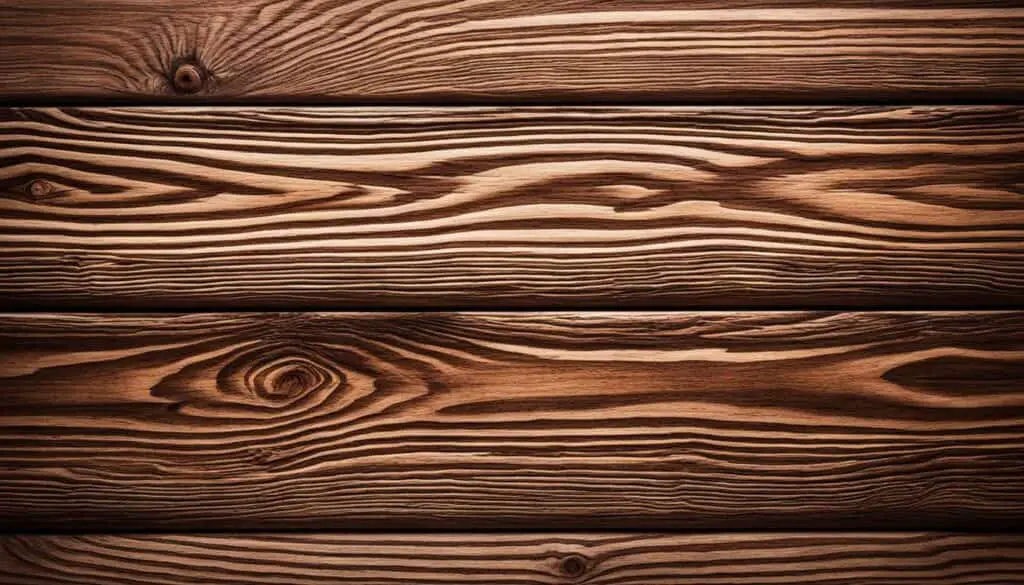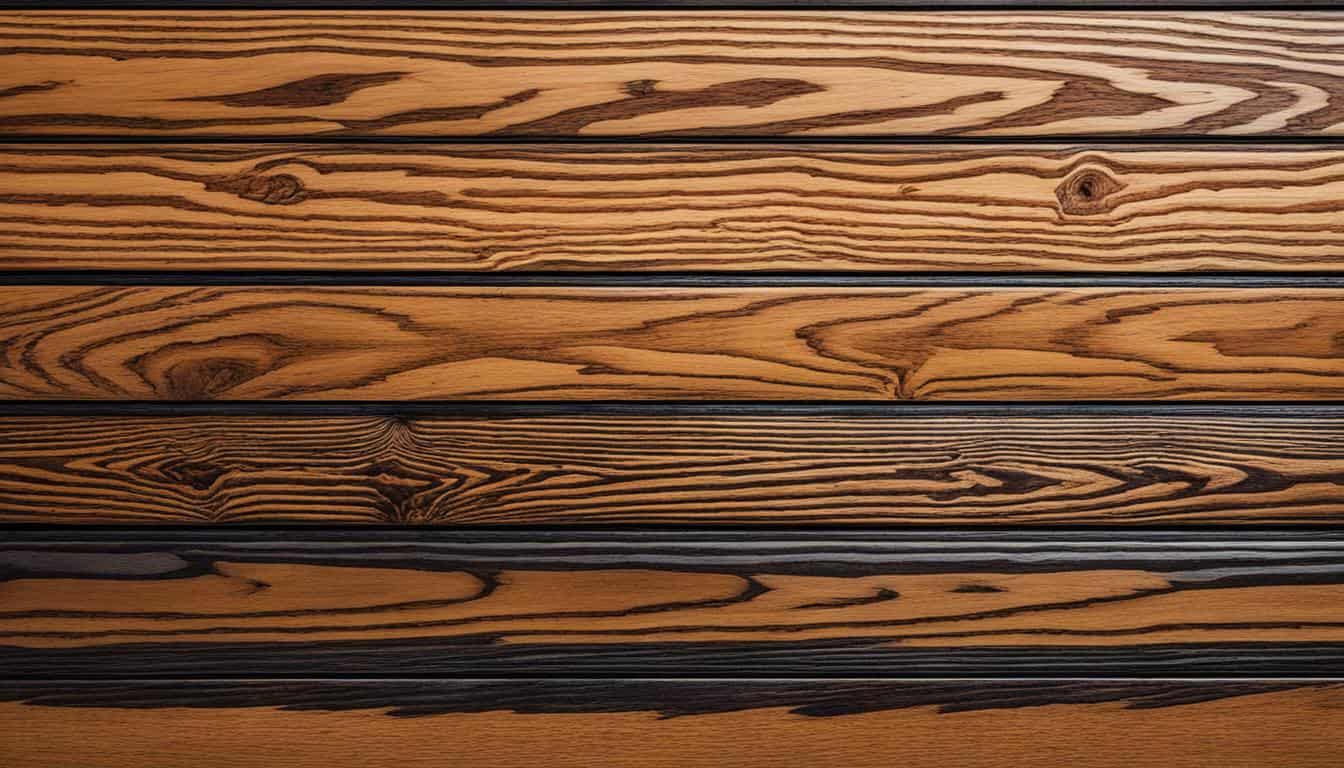Are you looking to enhance the natural beauty of your woodworking projects with red oak stains and finishes? Discover expert tips and advice to achieve the perfect finish while minimizing overpowering red tones. Find out how a popular stain combo, Behr Water Based Stain, can help you create a beautiful, balanced finish on red oak wood.
Key Takeaways:
- Expert tips and advice for enhancing the natural beauty of red oak woodworking projects.
- Minimizing overpowering red tones while achieving the perfect finish.
- The benefits of using Behr Water Based Stain, a popular stain combo for red oak wood.
Preparing the Wood
Before applying stains and finishes to red oak, it’s important to properly prepare the wood. Follow these steps to ensure a smooth and successful application:
- Start by lightly sanding the wood with 180 or 220 grit sandpaper. This will create a smooth surface for even stain absorption.
- For red oak, it is not necessary to use a wood conditioner. The natural characteristics of the wood allow for good stain penetration.
- Fill in any nail holes with Minwax Natural Wood Filler. Apply the filler, let it dry, and sand it until it’s flush with the surface of the wood.
Properly preparing the wood ensures that the stains and finishes are applied evenly and adhere well to the red oak surface. This step is crucial for achieving the desired results and maximizing the beauty of the wood.
Benefits of Preparing the Wood:
“By sanding the wood and filling nail holes, you create a smooth base for the stains and finishes. This allows for even absorption and enhances the overall finish of your red oak projects.”
By following these preparatory steps, you’ll be well on your way to achieving professional-looking results with your red oak finishes. Now that the wood is ready, let’s explore the exciting world of stain combos in the next section.
Choosing the Stain Combo
When it comes to staining red oak, selecting the right stain combo is key to achieving the desired color and finish. With a wide range of red oak woodworking stains and red oak stain colors available, it can be overwhelming to make a choice. However, there are top stains for red oak that consistently deliver exceptional results.
One popular and effective stain combination for red oak consists of three stains mixed together. To create a beautiful, balanced finish while minimizing the red undertones in red oak wood, try the following combo:
1 part Golden Pecan Water Based Stain
1 part White Wash Pickling Water Based Stain
1/2 part Early American Water Based Stain
This stain combo not only helps to bring out the natural beauty of red oak but also creates a more neutral hue by reducing the prominence of red tones. The Golden Pecan stain adds warmth, the White Wash Pickling stain adds a touch of brightness, and the Early American stain provides depth and richness.
By carefully blending these stains, you can achieve a result that complements your red oak woodworking project and showcases the wood’s unique grain patterns.
Applying the Stain
When it comes to finishing red oak wood, applying the stain requires precision and efficiency. Water-based stains, in particular, dry quickly, so it’s important to work swiftly to achieve the desired results. Here’s a step-by-step guide on how to finish red oak wood effectively:
- Prepare the necessary materials, including the desired stain and a few essential tools. Protect your hands from staining by wearing a plastic glove underneath an old baby sock, which will serve as the applicator.
- Ensure the red oak wood surface is clean and free from any dust or debris. Use a clean cloth or tack cloth to wipe away any particles that may interfere with the staining process.
- Apply the stain in the direction of the wood grain using the baby sock applicator. The sock helps distribute the stain evenly on the surface, preventing any blotches or streaks.
- Work in small sections, moving steadily and consistently across the entire surface. This technique ensures a uniform application of the stain and avoids any noticeable variations in color.
- Immediately after applying the stain, use a clean rag to wipe off any excess. This step is crucial in achieving an even finish and preventing the stain from becoming too dark or blotchy.
| Tip | Explanation |
|---|---|
| Work in a well-ventilated area | Fumes from the stain can be strong, so it’s important to work in a properly ventilated space to ensure your safety and comfort. |
| Test the stain on a small area | Prior to staining the entire surface, it’s advisable to test the stain on a small, inconspicuous area of the red oak wood. This allows you to assess the color and ensure it matches your desired outcome. |
| Follow the manufacturer’s instructions | Each stain product may have specific instructions or recommendations for application. It’s essential to read and follow these instructions carefully to achieve optimal results. |
By following these steps and tips, you can finish red oak wood with confidence and achieve a beautiful, even stain that enhances the natural beauty of the wood grain.
Sealing the Wood
Once the stain has dried, it is time to seal the wood to protect the finish and enhance its longevity. Applying a topcoat is crucial for ensuring the durability of your red oak woodworking projects. For sealing red oak, three coats of water-based polyurethane are recommended, with a light sanding between each coat.
Water-based polyurethane is an excellent choice for indoor projects since it has less odor compared to oil-based polyurethane. It provides a clear, protective layer that guards against everyday wear and tear, such as scratches and moisture damage.
By applying multiple coats of water-based polyurethane, you create a robust barrier that safeguards the wood and enhances its beauty. Remember to allow proper drying time between coats to ensure a smooth and even application.
Benefits of Water-Based Polyurethane:
- Less odor: Water-based polyurethane has a lower odor compared to oil-based polyurethane, making it more suitable for use indoors.
- Quick drying: Water-based polyurethane dries faster than oil-based options, allowing for a quicker application process.
- Enhanced clarity: Water-based polyurethane provides a clear finish that beautifully showcases the natural grains and colors of the red oak wood.
- Easy cleanup: Water-based polyurethane can be easily cleaned with soap and water, making the cleaning process hassle-free.
Applying a topcoat of water-based polyurethane to your red oak woodworking projects not only enhances their appearance but also provides long-lasting protection. It’s an essential step in creating a beautiful and durable finish that will withstand daily use and maintain its luster over time.

Troubleshooting Staining Issues
Sometimes, staining red oak can result in blotchy or uneven results. This can be frustrating, but there are solutions to fix these issues and achieve a more even finish. Here are some tips to help you troubleshoot staining problems:
1. Strip the Stain
If you notice a blotchy stain on your red oak wood, it may be necessary to strip the existing stain using a product like citristrip. This will remove the old stain and allow you to start with a clean surface.
2. Re-sand the Wood
After stripping the stain, it’s important to properly sand and prepare the wood again before reapplying the stain. Use a fine-grit sandpaper to smooth out the surface and create an even base for the stain.
3. Practice on Scraps
Before applying the stain to the entire surface, it’s a good idea to practice on scrap pieces of red oak. This will help you determine the right technique and achieve the desired color and consistency before working on your main project.
4. Seek Professional Advice
If you’re still having trouble fixing the blotchy stain or achieving an even finish, don’t hesitate to seek professional advice. Woodworking experts can provide valuable insights and recommendations specific to your situation.
Remember, troubleshooting staining issues requires patience and attention to detail. By following these tips and techniques, you can overcome red oak staining challenges and achieve a beautiful, flawless finish for your woodworking projects.
| Common Staining Issues | Possible Solutions |
|---|---|
| Blotchy or uneven stain | Strip the stain and re-sand the wood before reapplying |
| Excessively dark or light stain | Adjust the stain-to-solvent ratio and test on scrap wood |
| Stain not penetrating the wood | Ensure proper sanding and removal of previous finishes |
| Inconsistent color or shade | Mix stains to achieve desired color and test on scrap wood |
Tips for Choosing the Right Stain Color
Choosing the right stain color for your red oak flooring can be a daunting task. It’s crucial to consider the natural undertones of red oak and select a stain that will balance out the red tones. One effective method is to choose a stain with green undertones, as green is the complementary color to red. By applying a stain with green undertones, you can achieve a more neutral and balanced color for your red oak floors.
When choosing a stain color, it’s essential to test it in different areas of your space. Lighting and existing decor can greatly affect how a stain appears. By testing the stain in various spots, you can ensure consistency and avoid any surprises.
Remember that the stain color you choose will have a significant impact on the overall look and feel of your space. Consider the style and ambiance you want to create and how the stain color will complement your existing furnishings and color scheme. Don’t be afraid to seek inspiration from design magazines, blogs, and professional interior designers to help you make an informed decision.
Here are a few popular red oak stain colors to consider:
- Golden Oak: This warm and light-toned stain brings out the natural grain of red oak while adding a touch of warmth.
- Provincial: A medium-toned stain with a slight reddish-brown hue, perfect for creating a classic and timeless look.
- Dark Walnut: For a rich and elegant feel, this dark stain adds depth and sophistication to red oak floors.
- Jacobean: A deep, dark brown stain that enhances the natural beauty of red oak while giving it a modern and sleek vibe.
Ultimately, the right stain color for your red oak floors will depend on your personal preferences and the overall aesthetic you want to achieve. Take your time, consider all the aspects, and choose a stain color that you’ll love for years to come.
DIY Staining Mistakes to Avoid
Staining red oak is a rewarding process that can elevate the look of your woodworking projects. However, there are some common DIY staining mistakes that you should steer clear of to achieve professional-looking results. By being aware of these pitfalls and following the right staining techniques, you can ensure a successful outcome for your red oak projects.
1. Applying Too Many Coats of Stain
One of the most common staining mistakes is applying too many coats of stain. While it might be tempting to achieve a darker color or enhance the richness of the wood, excessive layers can lead to an unnatural and uneven finish. Instead, follow the manufacturer’s instructions for the recommended number of coats and allow each layer to dry properly before applying the next.
2. Improperly Sanding the Wood
Properly sanding the red oak wood before staining is crucial for achieving a smooth and even finish. Neglecting this step can result in the stain being absorbed unevenly, leaving behind blotches and inconsistencies. Start with a medium-grit sandpaper and gradually switch to finer grits to ensure a polished surface. Take extra care to sand any rough spots, blemishes, or imperfections to create a flawless canvas for the stain.
3. Not Using a Wood Conditioner When Necessary
Depending on the type of stain you’re using and the condition of the red oak wood, a wood conditioner may be necessary to achieve an even stain absorption. Wood conditioners help to minimize blotchiness and create a more uniform finish. Before applying the stain, assess the wood’s porosity, and if necessary, apply a pre-stain wood conditioner according to the manufacturer’s instructions.
4. Not Testing the Stain in Different Areas
Another common mistake is not testing the stain in different areas of the wood before staining the entire surface. This step is crucial as the color of the stain can vary based on the wood’s natural characteristics and the presence of any previous finishes. By testing the stain in inconspicuous areas, you can ensure that the color and tone are to your liking, preventing any surprises when staining the entire piece.
By being mindful of these common staining mistakes and following these staining red oak tips, you can avoid unnecessary frustrations and achieve professional-quality results for your woodworking projects. Remember to take your time, practice on scrap pieces, and seek guidance from experts when needed. With patience and attention to detail, you’ll be able to bring out the natural beauty of red oak wood through stunning stains and finishes.
Refinishing Red Oak Handrails
Refinishing red oak handrails can be a challenging project, especially for beginners. To achieve a smooth and even finish, proper sanding, using a wood conditioner when needed, and choosing the right stain combo are crucial steps.
Step 1: Sanding
Start by sanding the red oak handrails to remove any existing finish or imperfections. Use a medium-grit sandpaper to smooth out rough areas and then switch to a fine-grit sandpaper for a polished finish. Make sure to sand with the grain of the wood to avoid scratches.
Step 2: Wood Conditioner
If your red oak handrails have uneven staining or if you want to minimize blotchiness, consider using a wood conditioner before applying the stain. A wood conditioner helps the stain penetrate the wood more evenly, resulting in a more consistent color.
Step 3: Choosing the Right Stain Combo
Choosing the right stain combo is essential for achieving the desired color and tone. Test different stain combinations on scrap pieces of red oak to see how they interact with the wood. Consider using a stain that complements the surrounding decor and enhances the natural beauty of the red oak.
Step 4: Applying the Stain
When applying the stain to red oak handrails, it’s important to work in small sections and apply the stain evenly. Use a brush or cloth to apply the stain, following the grain of the wood. After applying the stain, wipe off any excess to avoid streaks or blotches.
Step 5: Multiple Thin Coats
Instead of applying a thick coat of stain, it’s recommended to apply multiple thin coats for a more professional finish. Allow each coat to dry completely before applying the next one. This process helps build up the color gradually and ensures a more even and long-lasting finish.
Step 6: Protecting the Finish
To protect the finish of your red oak handrails, apply a clear polyurethane sealer once the stain has fully dried. The polyurethane sealer will add a protective layer and enhance the durability of the finish. Apply multiple coats, following the manufacturer’s instructions, and allow sufficient drying time between each coat.
Tip: Before starting any staining project, always ensure you have adequate ventilation in the area. Proper ventilation helps in achieving better staining results and ensures a safe working environment.
Expert Tip: Seek Professional Advice
If you’re unsure about refinishing red oak handrails or want expert guidance, don’t hesitate to seek advice from woodworking professionals. They can provide valuable insights and recommend specific techniques or products to achieve the best results.
Troubleshooting Staining Handrails
Staining handrails can sometimes result in blotchy or uneven stains. If this happens, it’s necessary to take appropriate steps to fix the issue and achieve a desirable finish for your red oak handrails.
1. Strip the Stain
If you notice blotchy or uneven stains on your handrails, the first step is to strip the existing stain. Use a reliable stain stripper product and follow the instructions carefully. This will help remove the uneven layer of stain and prepare the surface for a fresh application.
2. Re-Sand the Handrails
After stripping the stain, it’s important to re-sand the handrails to create a smooth surface. Start with a rougher grit sandpaper to remove any remaining stain or finish, then gradually move to finer grits for a polished result. Ensure the handrails are free from dust and debris before proceeding.
3. Consider Wood Conditioner
To prevent blotchiness in your stain application, consider using a wood conditioner before staining. Wood conditioners help the wood absorb the stain more evenly, reducing the chances of uneven patches or blotches. Apply the conditioner according to the manufacturer’s instructions and allow it to dry before proceeding with the stain.
4. Take Your Time and Practice
When staining handrails, it’s crucial to take your time and practice on scrap pieces before applying the stain to the entire surface. This will allow you to test different techniques and staining methods, ensuring you achieve the desired finish. Remember, patience and practice are key to achieving a professional-looking result.
5. Seek Guidance from Experts
If you’re facing persistent issues with staining your oak handrails, don’t hesitate to seek guidance from woodworking experts or professionals. They can provide valuable insights, recommend specific products or techniques, and help troubleshoot any staining problems you may encounter.
| Issue | Solution |
|---|---|
| Blotchy stains | Strip the stain, re-sand the handrails, consider using a wood conditioner, practice on scrap pieces |
| Uneven stains | Strip the stain, re-sand the handrails, consider using a wood conditioner, practice on scrap pieces |
| Seek professional guidance | Consult woodworking experts or professionals for assistance and advice |
By following these troubleshooting steps and seeking professional guidance if needed, you can overcome the challenges of blotchy or uneven stains on your oak handrails. Take the time to refine your staining technique, and soon you’ll achieve the beautiful and even finish you desire.

Expert Tips for Staining Red Oak Furniture
Staining red oak furniture requires attention to detail and proper technique. By following these expert tips, you can achieve a beautiful and durable finish for your red oak pieces.
Sanding
Start by sanding the furniture thoroughly to create a smooth surface. Use 120 to 150 grit sandpaper to remove any imperfections and smooth out the wood grain. Sanding also helps the stain penetrate evenly into the wood.
Choosing the Right Stain Combo
Choosing the right stain combo is crucial for achieving the desired color on your red oak furniture. Consider using a mixture of water-based stains, such as Minwax Wood Finish in English Chestnut and Varathane Fast Dry Wood Stain in Weathered Gray. This combination creates a warm, rustic look with subtle gray undertones.
Even Application
Apply the stain using a clean, lint-free cloth or a foam brush. Work in small sections, applying the stain in the direction of the grain. Ensure an even application by wiping off any excess stain immediately with a clean cloth. This helps prevent blotchy or uneven results.
Allowing Drying Time
After applying the stain, allow it to dry completely before moving on to the next step. This usually takes about 24 hours, but it’s best to follow the manufacturer’s recommendations. Drying time may vary depending on the humidity and temperature of your workspace.
| Expert Tip | Why It’s Important |
|---|---|
| Always test the stain on a scrap piece of red oak before applying it to your furniture. | Testing the stain allows you to see how it reacts with the wood and how the color develops. It helps you determine if the chosen stain combo is suitable for your project. |
| Wear protective gloves and work in a well-ventilated area when applying the stain. | Protective gloves prevent stain absorption through the skin, and proper ventilation ensures a safe working environment. Stain fumes can be harmful if inhaled in large quantities. |
| Apply multiple coats of stain for a deeper and richer color. | Layering the stain allows for better color saturation and depth. It also helps you achieve a more uniform color throughout the furniture piece. |
Once the stain has dried, you can apply a protective topcoat, such as polyurethane, to seal the wood and provide added durability. Follow the manufacturer’s instructions for the topcoat, and make sure to allow proper drying time between coats.
With these expert tips, you can confidently stain your red oak furniture and bring out its natural beauty.
Tips for Successful Red Oak Staining Projects
Successful red oak staining projects rely on proper preparation, choosing the right stain combo, and applying the stain with care. To achieve even oak stain, follow these expert tips:
- Sand the wood properly: Start by sanding the red oak wood with fine-grit sandpaper, such as 180 or 220 grit, to create a smooth surface for the stain to absorb evenly.
- Use a wood conditioner: Depending on the type of stain you choose, a wood conditioner may be necessary to achieve a more consistent color. Apply the conditioner according to the manufacturer’s instructions.
- Test the stain in different areas: Before applying the stain to the entire surface, test it on a small, inconspicuous area to ensure you achieve the desired color and coverage.
- Work in a well-ventilated area: Staining oak can release fumes, so it’s important to work in a well-ventilated area or use a respirator to protect yourself from harmful chemicals.
- Follow the manufacturer’s instructions: Each stain and topcoat may have specific instructions for application, drying times, and additional coats. Be sure to read and follow the instructions carefully for the best results.
- Apply the stain with care: Use a high-quality brush, sponge, or cloth to apply the stain in even strokes, following the natural grain of the wood. Wipe off any excess stain to prevent blotching or unevenness.
- Allow proper drying time: After applying the stain, allow it to dry completely before applying any topcoat or sealer. Follow the recommended drying time provided by the manufacturer.
By following these tips and techniques, you can achieve successful red oak staining projects and enjoy the natural beauty of even oak stain.
Benefits of Water-Based Stains for Red Oak
When it comes to staining red oak, water-based stains offer numerous advantages over their oil-based counterparts. If you’re wondering why you should choose water-based stains for your woodworking projects, here are some benefits to consider:
1. Less Odor
One of the significant advantages of water-based stains is their low odor compared to oil-based stains. This makes them an ideal choice for indoor projects, where strong odors can be unpleasant or even harmful to your health. With water-based stains, you can work comfortably in a well-ventilated area without worrying about overpowering smells.
2. Quick Drying
Water-based stains dry much faster than oil-based stains. This means you can complete your staining projects in less time as you won’t have to wait as long between coats or before applying a topcoat. The quick drying time allows for efficient application and reduces the risk of dust or debris settling onto your freshly stained surfaces.
3. Wide Range of Colors
Water-based stains come in a wide variety of colors, making it easier to find the perfect shade for your red oak projects. Whether you prefer a natural, lighter tone or a deeper, richer color, there is a water-based stain available to suit your preferences. With the extensive range of colors, you can achieve the precise look you desire for your woodworking creations.
4. Environmentally Friendly
Water-based stains are generally considered more environmentally friendly compared to oil-based stains. They have lower levels of volatile organic compounds (VOCs), which can be harmful to the environment and human health. By choosing water-based stains, you can contribute to a cleaner and greener woodworking process.
Overall, the benefits of water-based stains for staining red oak make them a popular choice among woodworking enthusiasts. Their low odor, quick drying time, extensive color options, and eco-friendliness make them a versatile and suitable option for all your red oak staining needs.
| Advantages | Water-Based Stains | Oil-Based Stains |
|---|---|---|
| Odor | Less odor | Strong odor |
| Drying Time | Quick drying | Slower drying |
| Color Options | Wide range of colors | Limited color options |
| Environmental Impact | Lower VOC levels | Higher VOC levels |
Applying Water-Based Poly to Red Oak
Water-based polyurethane is a popular choice for sealing red oak furniture. Its durable and protective properties make it ideal for preserving the beauty of your red oak projects for years to come. To ensure a successful application, follow these steps:
- Prepare the surface: Start by lightly sanding the stained surface with fine-grit sandpaper to create a smooth foundation for the polyurethane.
- Apply thin, even coats: Use a high-quality brush or a foam applicator to apply thin and even coats of water-based polyurethane. Working in small sections, apply the polyurethane in the direction of the wood grain for a seamless finish.
- Allow proper drying time: Follow the manufacturer’s instructions for the recommended drying time between coats. This will ensure that each coat fully dries and adheres properly.
- Lightly sand between coats: After each coat has dried, lightly sand the surface with fine-grit sandpaper. This will help create a smooth finish and remove any imperfections or bubbles.
By applying water-based polyurethane to your red oak furniture, you can seal and protect the wood while enhancing its natural beauty. Remember to work in a well-ventilated area and follow the manufacturer’s instructions for the best results.
“Water-based polyurethane is a great option for sealing red oak furniture. It provides excellent protection while maintaining the natural look of the wood.” – Woodworking Expert
Tips for Caring for Red Oak Finishes
To maintain the beauty and longevity of your red oak finishes, it’s essential to follow proper care and maintenance practices. By taking the necessary steps, you can protect your oak wood furniture and ensure it remains in excellent condition for years to come.
Cleaning Red Oak Surfaces
To keep your red oak finishes looking their best, regularly clean the surfaces using gentle methods. Avoid harsh chemicals that can damage the finish. Instead, opt for furniture polish or a damp cloth to remove dust and debris. This will help preserve the natural shine and luster of the wood.
Preventing Heat Marks
One common issue with red oak finishes is the formation of heat marks caused by placing hot objects directly on the surface. To prevent this, always use coasters, trivets, or table pads under hot items such as pans or mugs. This simple precaution will safeguard your red oak furniture from unsightly heat marks and ensure its long-term beauty.
Protecting from Spills and Scratches
Accidents happen, but you can safeguard your red oak finishes from spills and scratches. Utilize coasters, placemats, or tablecloths to protect the surface from spills that could potentially stain or damage the finish. Additionally, consider using felt pads under objects that may scratch the wood, such as vases or decorative items. These proactive measures will help maintain the integrity of your red oak furniture.
Expert Tip: By practicing proper care and proactive protection, you can extend the lifespan of your red oak finishes and keep them looking beautiful for generations to come.
Completing the Care Routine
In addition to the above tips, it’s important to periodically inspect your red oak finishes for any signs of wear or damage. If you notice any issues, address them promptly to prevent further deterioration. Consider applying a fresh coat of finish or consulting a professional for expert advice.
Remember, proper care and maintenance go a long way in preserving the beauty and longevity of your red oak finishes. By following these tips and incorporating them into your routine, you can enjoy the natural warmth and elegance of oak wood furniture for many years to come.
| Care Tips | Benefits |
|---|---|
| Regularly clean with furniture polish or a damp cloth | Preserves the natural shine and luster of the wood |
| Use coasters or table pads to prevent heat marks | Protects the finish from unsightly marks caused by hot objects |
| Utilize coasters, placemats, or tablecloths to prevent spills | Guards against stains and damage caused by spills |
| Use felt pads under objects to prevent scratches | Preserves the surface integrity by minimizing scratches |
Conclusion
Staining and finishing red oak can be a rewarding woodworking project when done correctly. By following expert tips and utilizing the right stain combos, you can enhance the natural beauty of red oak wood. To ensure successful results, it’s important to properly prepare the wood by sanding and filling any imperfections. Choosing the right stain combo, such as Behr Water Based Stain, can help minimize overpowering red tones and create a balanced finish.
Applying the stain requires working quickly with an applicator like an old baby sock, and wiping off any excess to achieve an even application. Once the stain has dried, sealing the wood with multiple coats of water-based polyurethane provides long-lasting protection. Remember to avoid common DIY staining mistakes and troubleshoot any issues that may arise. Seeking expert advice and guidance can be invaluable in ensuring the success of your red oak staining projects.
In conclusion, with patience, attention to detail, and the use of high-quality products, you can transform red oak into stunning woodworking projects. Whether it’s furniture, handrails, or floors, proper staining and finishing techniques will help you achieve the desired results. So go ahead, unleash your creativity, and enjoy the process of bringing out the natural beauty of red oak with expert tips for staining and finishing.
FAQ
How do I prepare the wood before applying stains and finishes to red oak?
Start by lightly sanding the wood with 180 or 220 grit sandpaper to create a smooth surface for even stain absorption. For red oak, it is not necessary to use a wood conditioner. Fill in any nail holes with Minwax Natural Wood Filler, and sand it before it dries.
What stain combo should I choose for red oak?
A popular and effective stain combo for red oak is 1 part Golden Pecan Water Based Stain, 1 part White Wash Pickling Water Based Stain, and 1/2 part Early American Water Based Stain. This combo helps minimize the red undertones in red oak wood and creates a beautiful, balanced finish.
How should I apply the stain to red oak?
Work quickly as water-based stains dry quickly. Use an old baby sock as an applicator, wearing a plastic glove underneath to keep hands stain-free. Apply the stain in the direction of the grain and immediately wipe off any excess with a rag.
Should I apply a topcoat after staining red oak?
Yes, it is recommended to apply a topcoat to seal the wood and protect the finish. Three coats of water-based poly are typically applied, with a light sanding between coats.
How do I fix blotchy stain on red oak?
To fix blotchy stain, strip the stain using a product like citristrip and then re-sand the wood. Properly sand and prepare the wood again before reapplying the stain.
What are some tips for choosing the right stain color for red oak?
Consider the natural undertones of red oak and select a stain with green undertones to balance out the red. Test the stain in different areas to ensure consistency.
What are some common DIY staining mistakes to avoid?
Some common mistakes to avoid include applying too many coats of stain, not sanding the wood properly, not using a wood conditioner when necessary, and not testing the stain in different areas.
How do I refinish red oak handrails?
Properly sand the handrails, use a wood conditioner if needed, and apply multiple thin coats of stain for a professional result.
How do I troubleshoot staining issues on handrails?
If handrails have blotchy or uneven stains, strip the stain using appropriate products and re-sand the handrails. Using a wood conditioner can help prevent blotchiness.
What are some expert tips for staining red oak furniture?
Start by sanding the furniture thoroughly, choose the right stain combo, apply the stain evenly, wipe off any excess, and apply a topcoat for added protection.
What are some tips for successful red oak staining projects?
Properly prepare the wood, choose the right stain combo, and apply the stain with care. Take your time, work in a well-ventilated area, and follow the manufacturer’s instructions for the chosen stain and topcoat.
What are the benefits of using water-based stains for red oak?
Water-based stains have less odor, dry quickly, and offer a wide range of colors. They are more suitable for indoor projects compared to oil-based stains.
How do I apply water-based polyurethane to seal red oak?
Lightly sand the stained surface, apply thin, even coats of water-based polyurethane, allowing proper drying time between coats. Lightly sand between coats for a smooth finish.
How do I care for red oak finishes?
Clean the surfaces regularly with furniture polish or a damp cloth, avoid harsh chemicals, do not place hot objects directly on the surface, and use coasters or table pads to protect against spills and scratches.
What are some concluding tips for red oak stains and finishes?
Follow proper preparation, apply stains and finishes with care, and choose top-quality products. Seek guidance from experts if needed and enjoy the process of creating stunning red oak woodworking projects.












